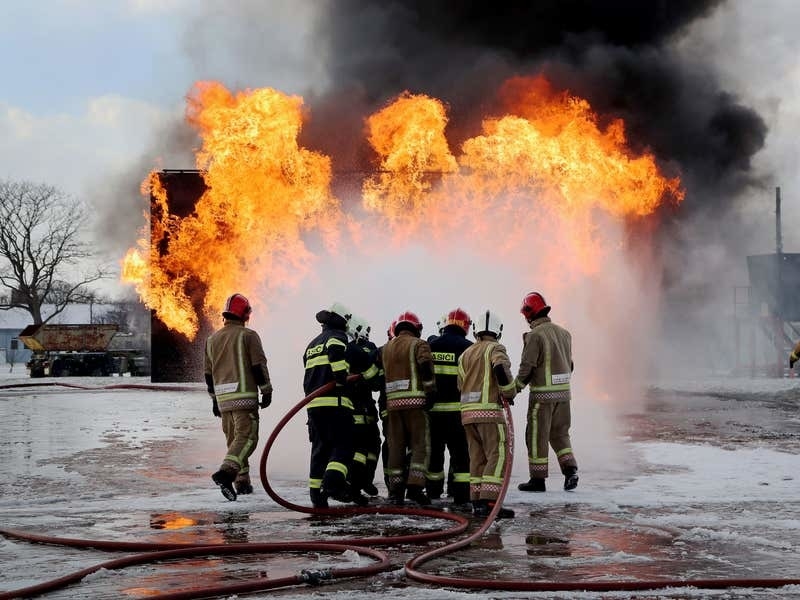The Government is considering banning the use of certain chemicals in firefighting foam, an environment minister has said, after analysis found it to be a significant source of environmental pollution and occupational exposure.
Known as “forever chemicals” because of their environmental durability, per- and polyfluoroalkyl substances (PFAS) are a group of nearly 9,000 chemicals valued for their oil and water-resistant properties.
Two types, PFOA and PFOS, have been linked to serious health conditions affecting the stomach, liver and thyroid, but their use is now restricted.
Environment Agency testing suggests they are present in most groundwater, surface water, plants and animals in England.
New analysis from the Health and Safety Executive (HSE), focusing on a smaller PFAS class of hundreds which are the most persistent, identified firefighting foam to be a significant source of PFAS pollution and occupational exposure.
It recommends restricting the use of foam with PFAS as well as the manufacture and sale of consumer articles likely to cause pollution or exposure such as textiles, leather, clothes, rugs, carpets, paints, varnishes, waxes, polishes and cleaning products.
The HSE also suggested developing statutory standards for PFAS in drinking water in England and Wales.
The Drinking Water Inspectorate currently offers guidance to water companies to ensure PFAS contamination does not exceed 0.1 micrograms per litre.
The US Environmental Protection Agency has proposed setting a limit of 0.000004 micrograms per litre for PFOA and PFOS in drinking water, which it believes would save thousands of lives.
Environment minister Rebecca Pow said: “The HSE’s analysis is a key part of our efforts to protect us from these persistent chemicals – our Plan for Water recognises this and we will begin developing proposals to restrict PFAS in firefighting foams this year.
“This will build on our action to increase monitoring and support a ban or highly restrict specific PFAS both domestically and internationally so that we can reduce the amount of PFAS entering our natural environment.”
Riccardo la Torre, national officer with the Fire Brigades Union, said: “We are still digesting this report and will be considering whether these recommendations go far enough to protect firefighters from the serious health risks of PFAS.
“What is clear is that exposure to dangerous chemicals has been allowed to be part of firefighters’ work for far too long. Firefighters are getting ill and dying while the Government and employers fail to act.”
The HSE published its regulatory management options analysis (RMOA) through UK Reach, the framework used to manage risks of chemical pollution in Great Britain.
It found there are between 2,600 and 36,700 tonnes of PFAS substances on the market in Great Britain, not including those manufactured or imported at less than one tonne per annum, already in finished products, or subject to transitional provisions after Brexit.
Dr Richard Daniels, director of the HSE’s chemicals regulation division, said: “PFAS are a global issue of concern. We have looked at responses around the world, but it was vital we gathered the right information and evidence on how PFAS are used in Britain specifically.”
#SaveOurWildIsles from #PFAS pollution!
New studies found high levels of PFAS #chemicals in English rivers, some more than 10X higher than newly proposed EU safety levels.
We’re calling on @UKGov to act. Like & share to show you care ? #12KeyAsks https://t.co/PG68a85I49 pic.twitter.com/z1HCXrPaQs
— Wildlife and Countryside Link (@WCL_News) April 3, 2023
The HSE said firefighting foam should be prioritised but PFAS should be phased out of other industrial and commercial usages too.
Dr Daniels added: “There is evidence of occupational exposure and environmental harm that can come from current firefighting foams, and we can understand the concerns among firefighters. We encourage all affected to work with us in the scoping exercise.”
Environmental and health campaigners welcomed the HSE’s recommendations but said there must be a complete phase-out of PFAS to lower contamination.
Thalie Martini, chief executive of Breast Cancer UK, said: “The options analysis shows a step in the right direction but does not, ultimately, go far enough.
“Human exposure to forever chemicals remains much higher than we believe is safe, creating an increased risk of breast cancer.
“The only way to truly lower our risk is to remove as many of these chemicals as we can and move towards a complete phasing out in the near future, as countries across Europe are starting to do.”
Hannah Conway, chemical policy officer at Wildlife and Countryside Link, added: “With forever chemicals there is only prevention, there is no cure.
“Once they are released into the environment these substances are extremely difficult to remove, which is why it’s so vital that updated PFAS regulations and the UK Chemicals Strategy provide the sea-change needed on this and other harmful chemicals.
“A total PFAS phase-out is the only remedy to help put the health of our waters and nature back on track.”






